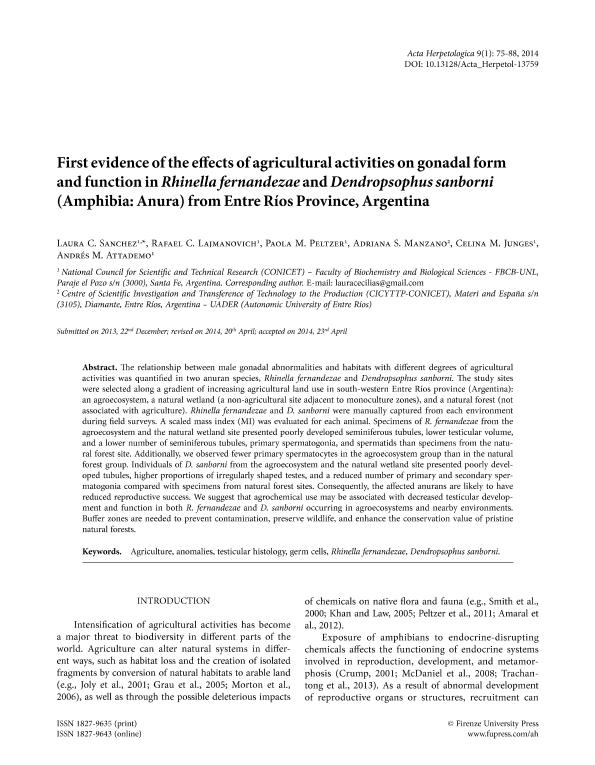Mostrar el registro sencillo del ítem
dc.contributor.author
Sanchez, Laura Cecilia

dc.contributor.author
Lajmanovich, Rafael Carlos

dc.contributor.author
Peltzer, Paola

dc.contributor.author
Manzano, Adriana Silvina

dc.contributor.author
Junges, Celina Maria

dc.contributor.author
Attademo, Andres Maximiliano

dc.date.available
2017-12-19T20:40:17Z
dc.date.issued
2014-06
dc.identifier.citation
Attademo, Andres Maximiliano; Junges, Celina Maria; Manzano, Adriana Silvina; Peltzer, Paola; Lajmanovich, Rafael Carlos; Sanchez, Laura Cecilia; et al.; First evidence of the effects of agricultural activities on gonadal form and function in Rhinella fernandezae and Dendropsophus sanborni (Amphibia: Anura) from Entre Ríos Province, Argentina; Firenze University Press; Acta Herpetologica; 9; 1; 6-2014; 123-136
dc.identifier.issn
1827-9635
dc.identifier.uri
http://hdl.handle.net/11336/31069
dc.description.abstract
The relationship between male gonadal abnormalities and habitats with different degrees of agricultural activities was quantified in two anuran species, Rhinella fernandezae and Dendropsophus sanborni. The study sites were selected along a gradient of increasing agricultural land use in south-western Entre Ríos province (Argentina): an agroecosystem, a natural wetland (a non-agricultural site adjacent to monoculture zones), and a natural forest (not associated with agriculture). Rhinella fernandezae and D. sanborni were manually captured from each environment during field surveys. A scaled mass index (MI) was evaluated for each animal. Specimens of R. fernandezae from the agroecosystem and the natural wetland site presented poorly developed seminiferous tubules, lower testicular volume,and a lower number of seminiferous tubules, primary spermatogonia, and spermatids than specimens from the natural forest site. Additionally, we observed fewer primary spermatocytes in the agroecosystem group than in the natural forest group. Individuals of D. sanborni from the agroecosystem and the natural wetland site presented poorly developed tubules, higher proportions of irregularly shaped testes, and a reduced number of primary and secondary spermatogonia compared with specimens from natural forest sites. Consequently, the affected anurans are likely to have reduced reproductive success. We suggest that agrochemical use may be associated with decreased testicular development and function in both R. fernandezae and D. sanborni occurring in agroecosystems and nearby environments.Buffer zones are needed to prevent contamination, preserve wildlife, and enhance the conservation value of pristine natural forests.
dc.format
application/pdf
dc.language.iso
eng
dc.publisher
Firenze University Press

dc.rights
info:eu-repo/semantics/openAccess
dc.rights.uri
https://creativecommons.org/licenses/by/2.5/ar/
dc.subject
Agriculture
dc.subject
Anomalies
dc.subject
Testicular Histology
dc.subject
Germ Cells
dc.subject
Rhinella Fernandezae
dc.subject
Dendropsophus Sanborni
dc.subject.classification
Otras Ciencias Biológicas

dc.subject.classification
Ciencias Biológicas

dc.subject.classification
CIENCIAS NATURALES Y EXACTAS

dc.title
First evidence of the effects of agricultural activities on gonadal form and function in Rhinella fernandezae and Dendropsophus sanborni (Amphibia: Anura) from Entre Ríos Province, Argentina
dc.type
info:eu-repo/semantics/article
dc.type
info:ar-repo/semantics/artículo
dc.type
info:eu-repo/semantics/publishedVersion
dc.date.updated
2017-12-18T15:08:01Z
dc.identifier.eissn
1827-9643
dc.journal.volume
9
dc.journal.number
1
dc.journal.pagination
123-136
dc.journal.pais
Italia

dc.journal.ciudad
Florencia
dc.description.fil
Fil: Sanchez, Laura Cecilia. Universidad Nacional del Litoral. Facultad de Bioquímica y Ciencias Biológicas; Argentina. Consejo Nacional de Investigaciones Científicas y Técnicas. Centro Científico Tecnológico Conicet - Santa Fe; Argentina
dc.description.fil
Fil: Lajmanovich, Rafael Carlos. Universidad Nacional del Litoral. Facultad de Bioquímica y Ciencias Biológicas; Argentina. Consejo Nacional de Investigaciones Científicas y Técnicas. Centro Científico Tecnológico Conicet - Santa Fe; Argentina
dc.description.fil
Fil: Peltzer, Paola. Universidad Nacional del Litoral. Facultad de Bioquímica y Ciencias Biológicas; Argentina. Consejo Nacional de Investigaciones Científicas y Técnicas. Centro Científico Tecnológico Conicet - Santa Fe; Argentina
dc.description.fil
Fil: Manzano, Adriana Silvina. Provincia de Entre Ríos. Centro de Investigaciones Científicas y Transferencia de Tecnología a la Producción. Universidad Autónoma de Entre Ríos. Centro de Investigaciones Científicas y Transferencia de Tecnología a la Producción. Consejo Nacional de Investigaciones Científicas y Técnicas. Centro Científico Tecnológico Conicet - Santa Fe. Centro de Investigaciones Científicas y Transferencia de Tecnología a la Producción; Argentina
dc.description.fil
Fil: Junges, Celina Maria. Universidad Nacional del Litoral. Facultad de Bioquímica y Ciencias Biológicas; Argentina. Consejo Nacional de Investigaciones Científicas y Técnicas. Centro Científico Tecnológico Conicet - Santa Fe; Argentina
dc.description.fil
Fil: Attademo, Andres Maximiliano. Universidad Nacional del Litoral. Facultad de Bioquímica y Ciencias Biológicas; Argentina. Consejo Nacional de Investigaciones Científicas y Técnicas. Centro Científico Tecnológico Conicet - Santa Fe; Argentina
dc.journal.title
Acta Herpetologica

dc.relation.alternativeid
info:eu-repo/semantics/altIdentifier/url/http://www.fupress.net/index.php/ah/article/view/13759
dc.relation.alternativeid
info:eu-repo/semantics/altIdentifier/doi/http://dx.doi.org/10.13128/Acta_Herpetol-13759
Archivos asociados
